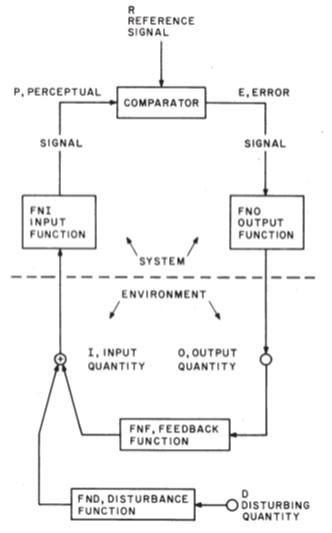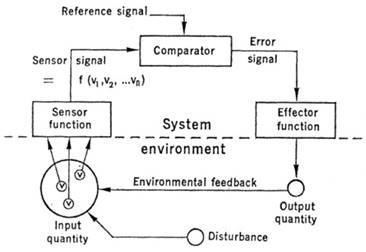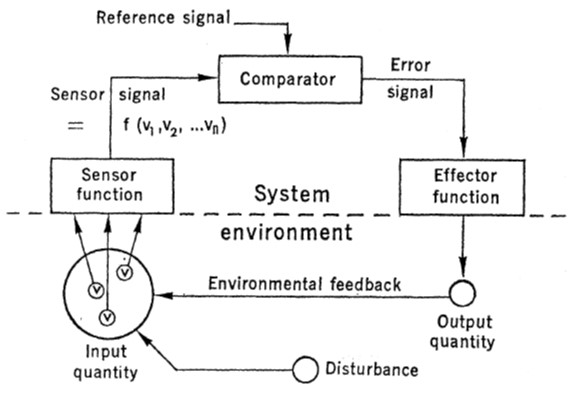[From Bruce Abbott (2017.02.26.1045 EST)]
Rick Marken (2017.02.25.1210) –
RM: Qi need exist as an input quantity only when there is an experimenter present who is interested in discovering what the controller is controlling. That is, when an experimenter is present doing the TCV.
RM: Qi is itself the output of a perceptual function in the observer. If the observer is a human it is unnecessary to know how it is computed; the observer’s nervous system does it for him.
RM: The observer is not part of the description of how a control system works.
I generally don’t like appeals to authority, but in this case Rick wants to establish that his position is Bill Powers’ position on the issue of what the input quantity (Qi) represents in the typical control-system diagram. So let’s see how Bill defines Qi and represents it in his diagrams. Rick bases his interpretation of Qi partly on a diagram found in Bill Powers’ (1973) Science article:

The first thing to note in this diagram is that the input quantity (the large circle on the left) is present in this diagram illustrating the components of a control system. According to Bill’s caption for this figure, “The Sensor function creates an ongoing relationship between some set of environmental physical variables (v’s) and a Sensor signal inside the system, an internal analog of some external state of affairs.” Then, in the body of the article, Bill states that the control system “must sense the controlled quantity in each dimension in which the quantity is to be controlled (Sensor function in Fig. 1); this implies the presence of an inner representation of the quantity in the form of a signal or set of signals.”
In so far as the Science paper is concerned, there is nothing here to suggest that the input quantity shown in the figure exists only in the mind of an observer. We need to look elsewhere.
In the Appendix to Behavior: The Control of Perception, Bill presents the following figure:

Here the input quantity is represented as a small circle with a plus-sign inside, indicating that it is a summing junction, adding together the inputs coming from the feedback function and the disturbance function. The output of the input quantity is shown entering the input function on the system side of the figure. Once again the input quantity is shown as a component of the control system, located in the system’s environment. Bill writes “The output quantity qo and the input quantity qi are expressed in physical units, whereas the signals . . . are neural events and must be expressed in signal-units (impulses per second).” There is no mention here of the input quantity consisting of little v’s. The reason for this lack of detail, I believe, is that this level of detail is unnecessary for Bill’s purpose, here in the Appendix, of describing the mathematical transformations within each of the control-system functions and showing, based on these functions, how one can compute the changes taking place in the system variables during the system’s operation. Once again, there is no mention of an observer.
Although the input quantity is located in the system’s environment, it is defined by the system’s input function, which determines which environmental variable or variables are sensed and how their levels are to be transformed into an internal signal p. When there are multiple variables being input, there may be no single entity in the environment that corresponds to this perception. However, there will be some particular combination of variables there that corresponds to Qi, for example, one that produces the recognizable taste of lemonade. Qi is not a perception in the mind of an observer, but rather an objective, potentially observable combination of environmental variables.
In neither case above has Bill found it necessary to introduce an observer into his discussion of how control systems are organized and work. He may have done so elsewhere (and if he did, I am sure Rick will be happy to point out where), but these examples make it clear that Qi can be defined and discussed without the added complication of an observer and the observer’s own input functions. If Bill finds that clarity of exposition is served by leaving the observer out when describing how a simple control system works, then why does Rick insist I am wrong to do so, and that his description (observer and all) is the only valid one?
Bruce
